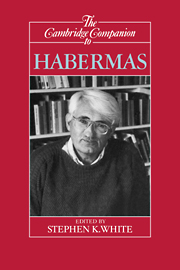Book contents
- Frontmatter
- PART I INTRODUCTION
- PART II HERITAGE AND CONTEXT
- 2 Identity and difference in the ethical positions of Adorno and Habermas
- 3 What's left of Marx?
- 4 Universalism and the situated critic
- PART III COMMUNICATIVE RATIONALITY
- PART IV DISCURSIVE DEMOCRACY
- PART V THE DEFENSE OF MODERNITY
- Select bibliography
- Index
3 - What's left of Marx?
from PART II - HERITAGE AND CONTEXT
Published online by Cambridge University Press: 28 May 2006
- Frontmatter
- PART I INTRODUCTION
- PART II HERITAGE AND CONTEXT
- 2 Identity and difference in the ethical positions of Adorno and Habermas
- 3 What's left of Marx?
- 4 Universalism and the situated critic
- PART III COMMUNICATIVE RATIONALITY
- PART IV DISCURSIVE DEMOCRACY
- PART V THE DEFENSE OF MODERNITY
- Select bibliography
- Index
Summary
'The liberal interpretation is not wrong. It just does not see the beam in its own eye.
With the bankruptcy of state socialism, [welfare state liberalism] is the eye of the needle through which everything must pass.
These passages, from Jürgen Habermas's “What Does Socialism Mean Today?,' surely sound strange. Biblical allusions to blindness and to heaven? From one who promotes communicative rationality as the “completion of the modern project”? From one who explicitly rejects nostalgic, romantic, and Utopian visions of socialism? Yet they provide clues that help explain Habermas's continued commitment to socialism. Socialism is not dead, nor will it rise again. In response to recent events, Habermas suggests a different, less dialectical, approach to resurrection. The possibilities of “actually existing socialism” are exhausted, but “socialism-as-critique” remains a source of hope. It retains the “intuitions” and “impulses” of a humanity that makes its history with conscious will. For Habermas, socialism is to be sustained as a “discourse-in-exile.” What's left of Marx in this is the tradition of Jewish mysticism.
- Type
- Chapter
- Information
- The Cambridge Companion to Habermas , pp. 46 - 66Publisher: Cambridge University PressPrint publication year: 1995
- 15
- Cited by

